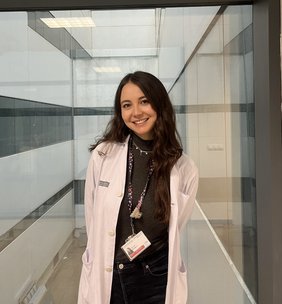Liver imaging and pregnancy: what to expect when your patient is expecting Giorgia Porrello, Roberto Cannella, Jacques Bernuau, Antoine Agman, Giuseppe Brancatelli, Marco Dioguardi Burgio and Valérie Vilgrain Insights into Imaging, 15, 66 (2024). DOI: https://doi.org/10.1186/s13244-024-01622-x Pregnancy is a complex period in a woman’s life during which numerous bio-physiological changes occur that predisposes to liver related disorders. This article summarises the “need-to-know” liver diseases that can debut or exacerbate during pregnancy, some of which can be life-threatening for both the mother and fetus. The authors emphasise essential imaging characteristics crucial for prompt diagnosis, highlighting the role radiologists play in their detection, screening and monitoring. Radiation exposure during gestation is also a major concern, which can limit the use of diagnostic imaging tests. However, the risk of abortion or congenital anomalies is negligible at doses below 50 mGy. The mean intrauterine dose for an abdominopelvic scan is approximately 5 mGy (1). Consequently, concerns about radiation should not impede imaging, especially in urgent scenarios. Nevertheless, the accessibility and safety of ultrasonography (US) make it the first-line diagnostic modality, and furthermore contrast-enhanced US is also considered a valid test. As an alternative, magnetic resonance (MR) is widely resorted to. A recent study did not find any association with death or neonatal morbidity in pregnancies exposed to gadolinium-based contrast agents (2). However, they should only be administered when strictly necessary, opting for macrocyclic contrast agents. The authors have categorised the hepatobiliary disorders during pregnancy into three distinct groups: 1) conditions related to pregnancy; 2) conditions exacerbated by pregnancy and 3) coincidental conditions. Conditions related to pregnancy include pregnancy intrahepatic cholestasis, pre-eclampsia/eclampsia, HELLP syndrome and acute fatty liver. In pregnancy intrahepatic cholestasis, which debuts with symptomatic increased serum bile acids, US helps in its differential diagnosis, ruling out the presence of gallstones and other complications. US also plays a crucial part in complicated pre-eclampsia by detecting liver alterations or portal thrombosis, which may require immediate delivery. Imaging becomes even more determining in eclampsia and HELLP syndrome, with US serving as the first-line test. It reveals decreased hepatic blood flow even before the onset of HELLP syndrome. Once established, key signs include liver hypertrophy, hyperechoic thickening of periportal space, edematous Glisson capsule and gallbladder wall, ascites and pleural effusion. However, CT is currently the gold standard for excluding severe complications such as liver infarction, haemorrhage, subcapsular hematoma and eventual liver rupture. Acute fatty liver of pregnancy (AFLP) is a sudden catastrophic disease occurring almost always in the third trimester and requires immediate delivery (3). Imaging alone is often inconclusive, and its diagnosis requires clinical and laboratory data, resorting to the Swansea criteria for its final diagnosis. Among other conditions, those exacerbated by pregnancy include Budd-Chiari syndrome (BCS), hereditary hemorrhagic telangiectasia, and hepatocellular adenoma. BSC can be triggered for the first time or exacerbated by pregnancy. Doppler-US serves as the primary diagnostic and screening modality, reserving MR when the prior is inconclusive. Hepatic venous occlusion and heterogeneous enlarged liver are common findings, and acute cases may show thrombus in the inferior vena cava. In hereditary hemorrhagic telangiectasia, a cardinal sign is a common hepatic artery diameter > 6mm and imaging is necessary to follow arteriovenous malformations and detect possible aneurysms. | Increased levels of estrogens prompt the growth of hepatocellular adenomas by up to 25%, requiring correct identification of the lesion, monitoring and detection of complications such as bleeding or spontaneous rupture. As in the general population, incidental focal liver lesions may be detected during gestation, which calls for accurate characterisation in suspicious cases; while benign features and a low pre-test probability can delay diagnostic imaging until childbirth. In known cirrhotic patients, close surveillance by radiologists is crucial as pregnancy may trigger hepatic decompensation with ascites or portal hypertension. While hepatocellular carcinomas are rare, they carry a poor prognosis due to aggressive growth and frequent rupture; therefore, diagnostic contrast-enhanced imaging techniques must be performed when suspected. Women who have undergone liver transplants are vulnerable to many of the mentioned disorders, including acute graft rejection and liver failure. Thus, careful monitoring, especially with Doppler-US throughout all trimesters, can lead to a successful outcome in 80% of pregnancies. In conclusion, the article underscores the relevant role of radiologists in the early and accurate diagnosis of pregnancy-related liver diseases, including common conditions that may have an unexpected turn, to ensure maternal-fetal health. Moreover, it highlights that the fear of radiation should never delay necessary imaging studies during pregnancy.
References:
Alice Hodgert is a first-year radiology resident at La Fe University and Polytechnic Hospital in Valencia (Spain), currently completing her first rotation in abdominal imaging. She graduated from the University of Valencia, where her ongrowing interest for specialising in radiology first sparked. Despite her little time in the radiology field, gastrointestinal imaging has captivated her attention and hopes to take in and learn as much as possible, while contributing in research in the upcoming years of her training. Comments may be sent to hodgertalice(at)gmail.com |

